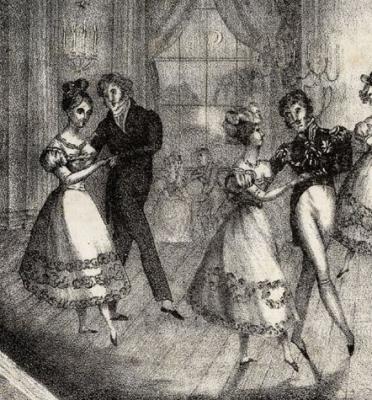- Historical Dance
- Jazz Age Social Dancing ("The Modern Dances")
- Ragtime Dance - the One Step
- Regency Dance
- "Mr Nelson's System of Simplified Regency Dance"
- An Analysis of Country Dancing - 1808
- Cotillions and Country Dances 1792
- Elements of the Art of Dancing - 1822
- The Complete System of English Country Dancing - 1815
- The Scholar's Companion - Cotillions and Country Dances - 1796
- Thos Wilson's Quadrille Instructor - Ca 1816
- Thos. Wilson's Description of Regency Waltzing - 1816
- Treasures of Terpsichore - 1816
- Victorian Dance
a. The Chasse Step and Pas Jeté Assemblé
This step, whose name means "chase", also called "glissade" (glide) is the fundamental step of the Regency era English Country dance. For those who dance Scottish Country Dance, you will immediately recognize it as the "Skip Change". It is the means of getting from one place to another in pretty much every 4/4 or 2/4 time English Country dance (which is most of them) of the period, with only an occasional slipping step or march here and there.

One starts by sliding the right foot forward, bringing the left up behind it, moving the right forward again and bringing the left up past the right to start the next pair of chasse steps, only this time with the left foot leading.
This is repeated twice, except on the last step, where the dancer ends with a pas jeté assemblé (more on this later).
Note: with this and almost every other step, when in doubt, start on the right foot. This even applies when you, for example, cross to the opposite side of the set, turn with a pas jetté assemblé, and then head back in the opposite direction. Even on the return trip, you will start the four beat step pattern on your right foot.
So, the pattern is right-close-right, right-close-right, left-close-left, left-close-left, right-close-right, right-close-right, pas jeté assemblé. The only exception to this is when the dancer is traveling for an extended period, such as in a Hay, when he will continue the chasse pattern for a longer period and only do the assemblé at the end of the figure.(seven chasses and a pas jeté assemblé rather than three chasses and a pas jeté assemblé).
The chasse is essentially a skipping step but can, depending on the character of the dance and the proclivities of the dancer, be done in a frenetic and energetic manner or a contained and graceful manner--or anywhere in between. If the dance is slow and stately, the chasse is slow and stately, and if the dance is fast and energetic, so is the chasse. The step is entirely adaptable to the character of the music.
I would strongly suggest that you "underplay" it. Make it only as strenuous as it has to be for that particular dance and avoid springing and bouncing. It is always best to try to be graceful, and you will also find after a five minute dance that this can be quite aerobic and there is much to be said for conservation of energy, especially for a gray haired dancer such as myself.
Here's my source: "Place the feet in the fifth position, the body erect, the knees turned outward; balance the body entirely on the leg that is behind; raise the heel of the foot that is before, bending at the same time on the other leg; raise yourself on the same leg, and at the same time slide the foremost foot, on the point, just to the second position, extending the knee and instep; when the foot arrives at the second position, let the body fall on it, and at the same time slide the other foot into the fifth position behind" (Strathy)
Pas Jeté Assemblé
The final part of the four or eight part pattern is the pas jeté assemblé (it means "step-kicked-assembled"). It is an essential punctuation that ends every distinct element in the dance. It is frequently used to turn in place.
To execute it, extend your left foot as you would if you were executing another chasse, then bring your left foot down to take your weight and simultaneously place your right foot behind your left leg, about mid way between your ankle and your knee.
Extend your right foot and then bring it back down, placing your right heel against your left instep.
Do not over extend or try to high kick. This is a very contained step.
You are ready to do it again.
Note: if you have timed it correctly, you will be at your final destination when you begin the assemblé. However, if you find you are short of your objective, you can easily correct by turning the initial left foot jeté into a small leap which brings you to your final destination, whereupon you complete the rest of the step.
Video of Kris Davey demonstrating the step
